Dwarf lemon trees are usually good option for people with limited space, but still want to enjoy the taste and benefits of fresh lemons. These miniature versions of traditional lemon trees are known for producing full-sized lemons despite their small size. They usually grow to be about 3 to 5 feet tall.
Dwarf lemon trees come in a variety of types, each with their own unique characteristics and growing requirements. These trees are very hardy and can tolerate a wide range of conditions, including low light and temperature fluctuations. They also require minimal pruning and can be fertilized with a balanced citrus fertilizer.
Okay, let us talk about dwarf lemons at length. Read through the article and am sure you will be satisfied and be ready to begin growing your lemons.
List of Dwarf Lemon Trees
- Dwarf Meyer Lemon
- Dwarf Eureka Lemon
- Dwarf Lisbon Lemon
- Ponderosa’ Dwarf Lemon Tree
- Santa Teresa dwarf lemon
- Four Seasons Dwarf Lemon Tree
- Genoa Dwarf Lemon Tree
- Lemonade’ Dwarf Lemon Tree
- Variegated Pink Lemon Tree
- Harvey Lemon Tree
Description of The Trees
Meyer Lemon

Meyer lemon trees were discovered in China where they are highly loved for their fruits, evergreen foliage, productive nature and aromatic scent.
Meyer usually reaches a height of between 3 and 6 feet. The tree produces small, round, bright yellow lemons that are sweeter and less acidic than traditional lemons.
Weather growing indoors or outdoors, the fruits are ready to harvest in the early winter through spring. The fruits are very fragrant and emit a bright, herbal scent with subtle spice-filled notes. The leaves too are fragrant.
The fruits also contain low acidity and a high sugar content, developing a sweet, zesty flavor with floral undertones.
The Dwarf Meyer Lemon tree is a hardy and can tolerate temperatures as low as 20°F as long as it is placed in a well-drained soil and watered regularly.
Meyer lemons are suitable for both fresh and cooked culinary applications. Today in United States, Meyer lemons are not commercially produced as their skin is very delicate and easily damaged.
Many people who have ever successfully grown Meyer lemon review positively its ability to produce fruits year-round and its resistance to most garden pests and diseases.
Dwarf Meyer Lemon trees can be propagated by seed, air layering and grafting. Meyer lemons will keep 5 to 15 days after being harvested.
Eureka Lemon tree
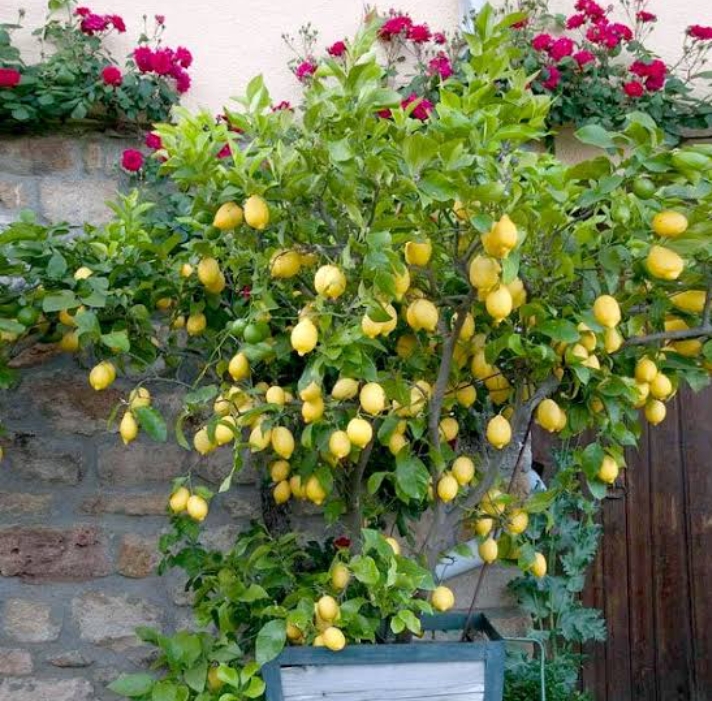
The Dwarf Eureka Lemons were first developed in Los Angeles, California in the mid-1800s. The trees of this lemon variety are characterized by abundant fruit production and ability to thrive even in small spaces.
The tree itself grows to be around 8 feet tall, with a much similar width. It has dark green glossy leaves, and produces white, fragrant flowers in the spring.
The fruit of this variety is similar to that of a traditional Eureka lemon, being medium to large in size, with a thick, smooth, and glossy rind.
The fruits have a round to oval shape with blunt, curved ends. The yellow-orange flesh is juicy and acidic, with a strong, distinct lemon flavor. Eureka lemons can be used in cookies, cakes, macarons, muffins, tarts or can be simmered into lemon curd.
The Dwarf Eureka Lemon tree can be used as a decorative or fruiting plant in gardens, patios and decks.
The tree will start producing fruit in about 2 or 3 years, and with proper care, it continues to bear fruit for many years. The fruits will always be available from early winter through spring.
The Dwarf Eureka Lemon tree is a hardy plant, and can tolerate even cold temperatures. It is also relatively resistant to pests and diseases.
Dwarf Lisbon Lemon tree

The Dwarf Lisbon Lemon tree are believed by many horticulturists to have been developed from the Gallego lemon, a variety native to Portugal.
Currently, it is one of the top varieties grown here in the United States for commercial production and in home gardens. It is generally a small citrus tree with abundant fruit production.
For those looking forward to grow their own citrus fruit in a small space, this will always be the best option. The tree can reach a height of around 8 feat.
The tree usually has fragrant white flowers in the spring. The lemons are available year-round with a peak season in the winter through late spring.
The lemon fruits are large and have a thick rind with a bright yellow color. The lemons’ flesh can sometimes be seedless or contain cream-colored seeds.
The flesh generally has a high acidity and strong citrusy aroma, creating a sour, tart and tangy taste. The Juice, flesh and zest can be used to add flavor to dishes or be mixed into dressings, marinades and oils.
The Dwarf Lisbon Lemon tree is very hardy. It can tolerate drought and temperatures as low as 20°F. The tree is also good when it comes to tolerating diseases and pest distraction.
The Ponderosa lemon tree
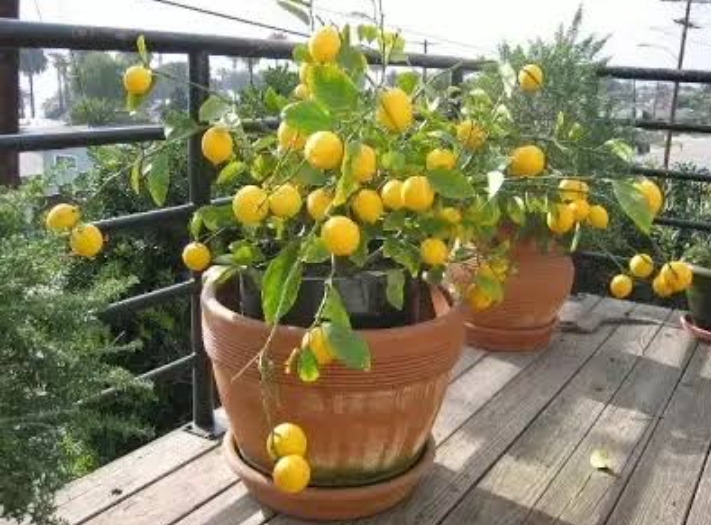
The Ponderosa lemon were discovered as a chance seedling in the Garden of Gorge Bowman in Hagerstown, Maryland in 1887.
While the exact parentage is unknown, lemon enthusiasts and horticulturists believe the cultivar’s appearance and characteristics points to a cross between a lemon and citron.
The Ponderosa lemon tree is generally a dwarf variety reaching around 6 feet tall in height. Do not confuse this variety with the hybrid variety that grow up to 25 feet tall.
The Ponderosa lemons are prolific in nature, producing fruits year-round and in some seasons, the flowers will be in bloom at the same time with the fruits.
The fruit can grow up to a relatively large size and weigh up to 2 pounds. The fruit has a thick, bumpy rind and a juicy, highly acidic flesh mixed with a subtle sweetness.
The tree is hardy to disease and changing climate. Though Pests such as aphids, scale, and citrus leafminer can have damaging effect on the plant.
The Ponderosa lemon tree will definitely do well if fertilized regularly with a balanced citrus fertilizer and is well-watered, especially during periods of drought.
Santa Teresa Dwarf Lemon
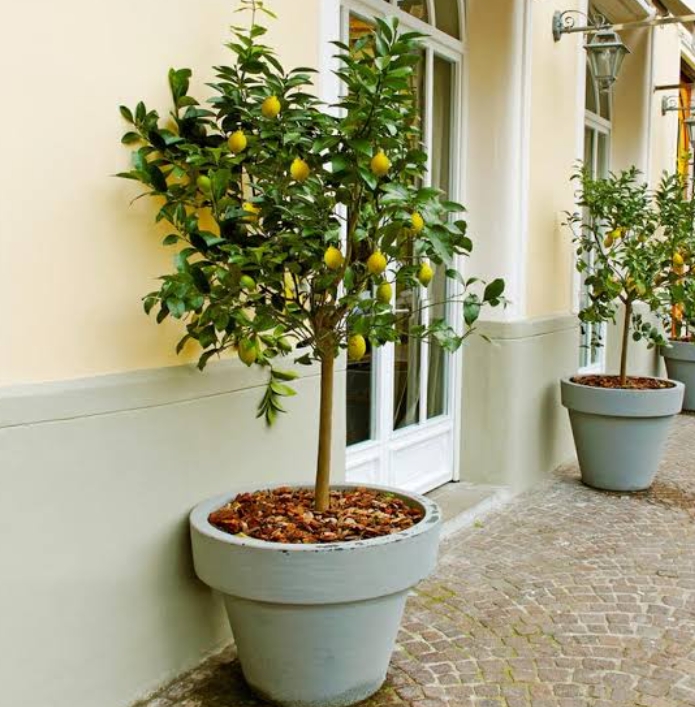
Santa Teresa dwarf lemons are native to the Sorrento Peninsula of Italy, along the Amalfi coast on the Mediterranean. There is also a large-size growing variety of Santa Teresa lemon.
The dwarf variety is a slow-growing in nature, reaching a mature height of between 3 and 6 feet tall. The tree is a heavy producer, and can yield as much as 50-100 pounds of lemons per year.
A standard Santa Teresa tree would reach 15 to 25 feet tall. This variety is usually grafted onto a dwarfing rootstock to limit its size for use in home gardens and containers.
Like many other varieties such as the pink lemonade tree, Santa Teresa may defy dwarfing when it’s grown in the ground outdoors. Some nurseries sell pink lemonade on non-dwarfing rootstock, so you need to carefully before you buy your tree.
Santa Teresa Dwarf lemon fruits are large in size with bright yellow thick rinds. They have a pure, vibrant, rich lemon flavor and release a rich citrus aroma when cut open. Their flavor is smooth and slightly sweet with high acidity.
Santa Teresa lemons are usually available for a short time in the late winter months. The tree is hardy and can withstand temperatures as low as 20 degrees Fahrenheit.
Sometimes referred to as Femminello Santa Teresa lemons, it is can definitely work well for those looking for a small tree with a heavy yield of sweet, juicy lemons.
Four Seasons Dwarf Lemon Tree

Lunario, commonly referred to as Four Seasons Lemon from the fact that during spring, summer, winter and fall, the tree continuously bears fruits and flowers. This is an Italian variety grown since the ancient Roman times —it appear in records and mosaics from that era.
The Lunario tree can grows to be about 5 feet in height with a dense, bushy habit. The leaves are dark green and elliptical, with a pointed tip, the buds are purple and grow both singly and in clusters.
The fruits have a bright yellow skin and are somewhat longer in shape than the other rounder lemon varieties. The fruits are also larger on average with each fruit averaging at least 100 grams.
The rind has an especially intense lemon aroma whereas the flesh is very juicy, acidic with sweet subtle.
These lemons can be used in both fresh and cooking applications, they can be served on the side of salads and meals as a dressing or even served with coffee.
When it comes to growing the Lunario outdoors in containers, it is important to know that they are very sensitive to frost, so it’s best to keep them indoors or in a greenhouse during cold weather.
To promote fruiting, you will have to fertilize the tree regularly with a balanced citrus fertilizer and regularly check for pests.
‘Genoa’ dwarf lemon tree

The ‘Genoa’ dwarf lemon tree is a vigorous growing tree with a dense canopy that easy to maintain below 10 feet. It is a true dwarf variety and will always be ideal to those with limited space.
The best thing about the ‘Genoa’ dwarf lemon tree is its heavy fruit production. This tree can produce an abundance of large, juicy fruits lemons with a classic lemon flavor.
This variety is believed to have originated in Italy, specifically in Genoa. The fruit ripens in late spring or early summer and the tree can continue to produce fruit throughout the year in warm climates.
The ‘Genoa’ dwarf lemon tree prefers a Mediterranean climate with mild winters and warm summers. When growing it indoors, it necessary you provide it with regular watering and fertilization to produce healthy growth and fruit.
The ‘Genoa’ dwarf lemon fruit can be used to add flavor to dishes such as marinades, dressings and sauces. The Juice and zest of this lemon can be used to make cocktails and other alcoholic beverages.
‘Lemonade’ Dwarf Lemon Tree
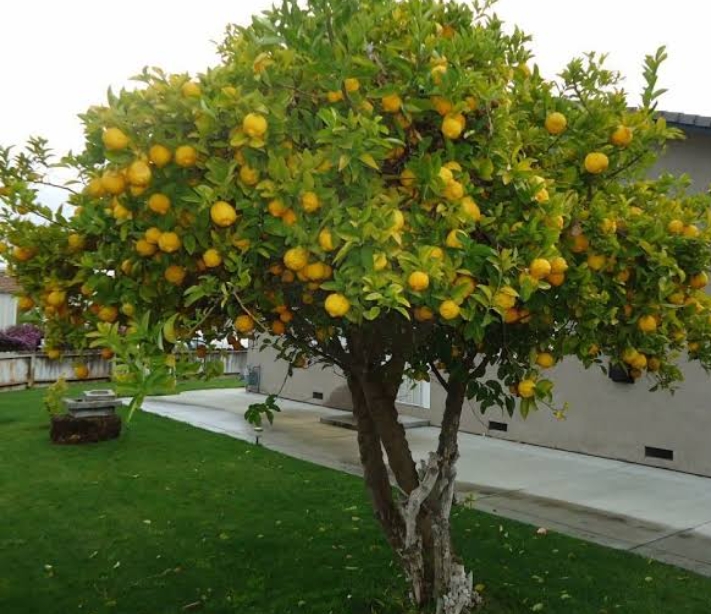
The ‘Lemonade’ Dwarf Lemon variety originated in Australia and it is a hybrid variety that is a cross between a lemon and a mandarin orange, which gives it its unique flavor.
It is a seedless unique citrus that resembles an orange or a mandarin. This delicious sweet, juicy fruit tastes like lemonade and can be eaten as a fresh fruit straight off the tree.
The tree is fast growing, has thorns and bears several heavy crops each year. The lemons are ready to harvest in late spring to early summer. The trees can averagely grow to be around 4 or 6 feet tall when grown indoors and is extremely sensitive to frost. It often defies dwarfing when it is grown in the ground outdoors.
Just like other lemon trees, this tree is easy to care for. If you happen to live in cold climate zones, you can grow this lemon outdoors but in containers. And when growing it indoors, avoid placing the tree near drafty windows or doors, or in areas where the temperature drops below 55°F.
Also remember, watering regularly too is important as well as fertilizing the tree with a citrus fertilizer twice a year will provide the necessary nutrients for the tree to thrive.
Variegated Pink Lemon Tree
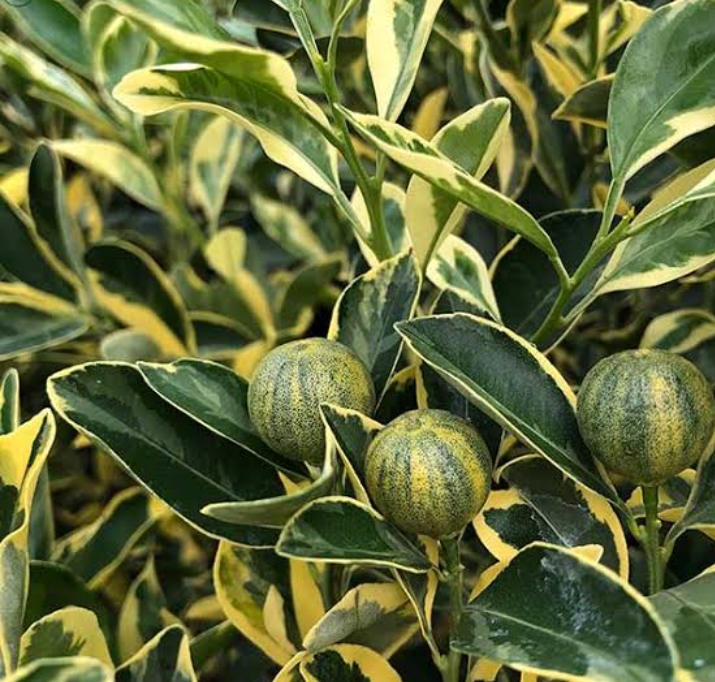
The variegated pink lemon, also called the variegated Eureka lemon, or pink-fleshed Eureka lemon is a traditional cultivar of lemon with unique pink flesh, a green-striped rind when ripening, and variegated foliage.
It was discovered as a bud sport on an ordinary Eureka lemon tree in Burbank, California, in 1931. A bud sport is part of a plant that has significant morphological variety from the rest of the plant.
The tree grows to be around 8 and 12 feet tall with a spreading habit, and translates well either as a landscape tree or as a dwarf container plant.
More often the tree defies dwarfing when grown in the ground outside and therefore if you need it dwarf, you will require to graft it onto a dwarfing rootstock to limit its size.
The leaves of this lemon are green with white, yellow or cream variegation. The leaves are glossy and have a slightly wavy edge. Pinkish-purple buds appear throughout the year and open as fragrant, white flowers.
The fruit of the tree is also unique, as it is a pale pink color rather than the traditional yellow of a lemon. The fruit is still edible and has a similar taste to a regular lemon, but it is less acidic and has a sweeter flavor.
The Variegated Pink Lemon is fast growing trees but at the same time frost sensitive and therefore if you happen to live in zones susceptible to cold winters, it is advisable to grow the lemon in containers or provide protection if frost threatens.
The Harvey lemon tree
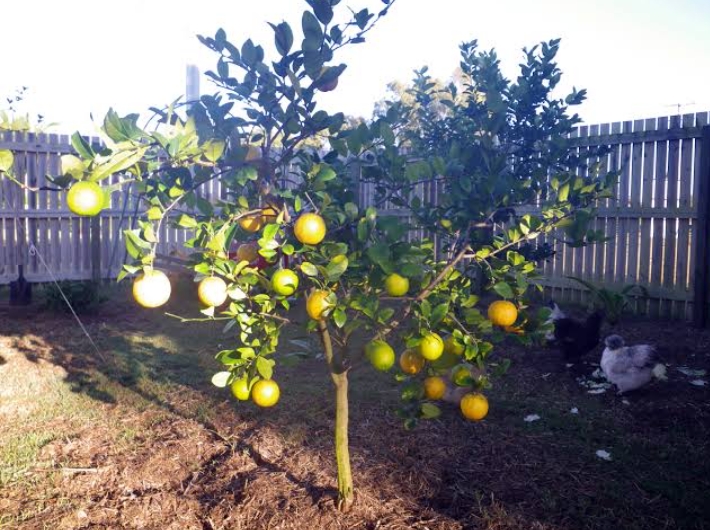
The Harvey lemon tree is a hybrid variety that was created by Harvey Smith in Florida by crossing a lemon and a mandarin. The tree is a heavy producer though fruit production can vary depending on a number of factors such as the tree’s age, the growing conditions and the care provided.
The standard Harvey lemon tree grows to approximately 15 feet tall when growing outdoor in the ground. Its size can be limited through pruning to be about 4 or 6 feet tall. Though the best way to limit its size is by grafting it onto a dwarfing rootstock.
The tree is not only good as a backyard tree, but it can also be grown commercially.
The fruit is medium to large in size, with a smooth, bright yellow rind that is relatively thick. Inside, the fruit is seedless, juicy and with a strong, acidic flavor. The fruit ripens in late winter or early spring.
Harvey Lemons can be used to add flavor to savory dishes such as fish, chicken and vegetables. The fruit can also be used to make preserves, jams and jellies. Its juice can be added to water, tea or cocktails for a refreshing drink.
Two of the most outstanding things about Harvey lemon tree is its ability to handle cold temperatures. It is cold hardy and can handle mild frost especially in areas with cool winters.
The second thing is that, the tree is resistant to common citrus diseases such as citrus canker and citrus greening which are known to significantly reduce the yield and quality of lemon fruits.